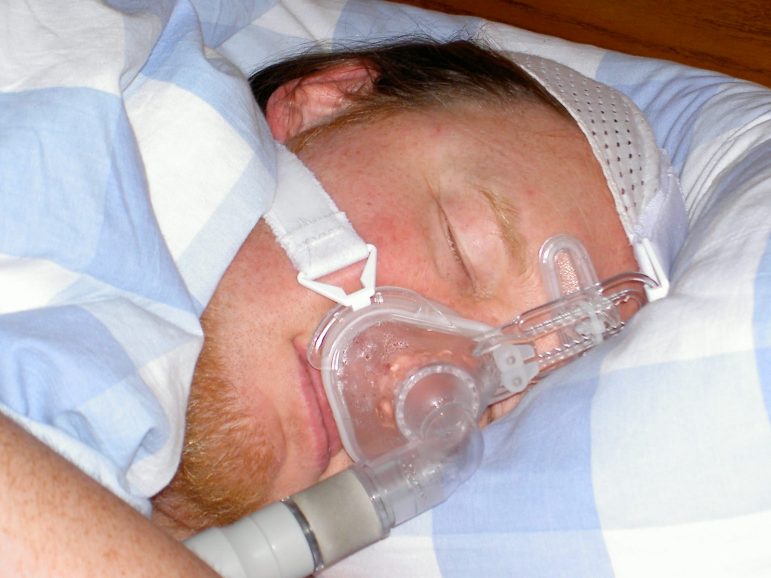Brian Burroughs knows all about sleep deprivation. He was once so drowsy all the time that he drank nearly 20 soft drinks a day, just to stay awake. He remembers the feeling well.
“I want to feel better. I want to be more productive. I want to be more alert. I still want to go swimming with my kids, and play with my kids, without being tired. Laying around all of the time, catching naps. I don’t need naps. So, I don’t want to have naps.”
Burroughs suffers from an array of sleep disorders, including obstructive sleep apnea. But, with help from the Sleep Disorder Center of Alabama, there’s light at the end of a sleepy, foggy tunnel.
Burroughs spends a night hooked up to monitors so doctors can figure out exactly what’s going on. Dr. Robert Doekel is the center’s medical director.
“When a person goes to sleep, and has obstructive sleep apnea, the airway is trying to close off in their sleep. The upper airway from your nose down to your windpipe is a tube that basically performs many functions. One is talking, one is breathing and the other one is for swallowing. And, there is a muscle for each of these functions. And, the airway being a collapsible tube, when you breathe in, there’s a tendency for the airway to want to collapse. Much the same way, if you try to drink a thick milk shake. If you suck hard on the straw, the straw wants to collapse.”
The muscle associated with breathing is supposed to keep this tube from collapsing. But, for people with obstructive sleep apnea, the muscle is not doing its job, and the airway closes. Individuals with sleep apnea literally stop breathing in the middle of the night.
And, here’s what happens next. Your body reads that you’ve stopped breathing. But, somehow it knows that if you wake up, you’ll start breathing again. So, it wakes you up. Some people jolt straight up in bed, others just shift, and never know they woke up at all. For those with sleep apnea, this doesn’t occur once or twice a week, or even a night. It can happen hundreds of times a night. The result-sufferers are unable to reach the deep sleep that allows them to feel fully rested.
Dr. Doekel says patients report that others tell them they sound like they’ve stopped breathing and then gasp for air in the middle of the night. And, then there’s the snoring. Not just normal snoring, but “Mom, was someone driving a motorcycle through the house, last night?” snoring. And, that can strain a relationship. Dr. Vernon Pegram is Director of the Sleep Disorder Center of Alabama
“Probably 40 or 50 percent of the patients, who come into our office, have already been sleeping separately from their spouse because they snore so loudly. That it’s uncomfortable, and one of the other gets up and leaves in the middle of the night. And, so they say, let’s just sleep in separate bedrooms, because this is unbearable.”
In addition to the personal toll, there are very serious physical consequences as well. Again, Dr. Doekel.
“Someone who has untreated obstructive sleep apnea is twice as likely to have high blood pressure problems. And, now we recognize sleep apnea as a treatable cause of hypertension. They’re three times more likely to have heart attacks, four times more likely to have strokes. And, roughly, five times more likely to have motor vehicle accidents because they’re fatigued, tired and sleepy in the daytime.”
The National Highway Traffic Safety Administration estimates that drowsy drivers cause 100,000 crashes a year — resulting in 75,000 injuries and 1,500 deaths annually.
“Especially with sleep apnea, the crash rate is two to four times higher in those with apnea than those in the general population. So, you can see that sleep deprivation severely impairs driving ability.”
Dr. Lawrence Epstine is past president of the American Academy of Sleep Medicine. He says there’ve been studies where tiny cameras are placed in cars, and researchers watch people’s eyes. They find that drivers, who were chronically sleep deprived for a period of time, were prone to “micro naps.” Very brief episodes of actually falling sleep for several seconds without being aware that it’s happened.
“Not such a big deal if it happens while you’re at a meeting with your boss, but it’s a big deal if it happens while you’re behind the wheel of a car traveling at seventy miles an hour.”
For those seeking relief from obstructive sleep apnea the cure is two-fold. First – confirm the diagnosis by spending the night at a sleep lab hooked to electrodes, from head to toe. Then – there’s treatment. The most common, and most successful, is the Continuous Positive Airway Pressure machine, or CPAP, for short. It blows air through the breathing passage, keeping it open throughout the night. This prevents muscles from contracting and causing any lack of oxygen.
As for Brian Burroughs, Dr. Pegram says during his last visit with his wife, both reported good news. Since sleeping with the CPAP machine and taking medication for his other sleep disorders, Burroughs has lost weight and kept it off, is in a better mood, can concentrate, has more attention to detail, and is living life wide awake, nap free.

